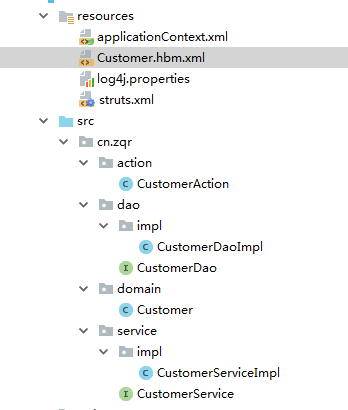整体结构:

1.引入相关jar包
2.编写实体类和映射文件


package cn.zqr.domain;
public class Customer {
private Long cust_id;
private String cust_name;
private Long cust_user_id;
private Long cust_create_id;
private String cust_source;
private String cust_industry;
private String cust_level;
private String cust_linkman;
private String cust_phone;
private String cust_mobile;
public Long getCust_id() {
return cust_id;
}
public void setCust_id(Long cust_id) {
this.cust_id = cust_id;
}
public String getCust_name() {
return cust_name;
}
public void setCust_name(String cust_name) {
this.cust_name = cust_name;
}
public Long getCust_user_id() {
return cust_user_id;
}
public void setCust_user_id(Long cust_user_id) {
this.cust_user_id = cust_user_id;
}
public Long getCust_create_id() {
return cust_create_id;
}
public void setCust_create_id(Long cust_create_id) {
this.cust_create_id = cust_create_id;
}
public String getCust_source() {
return cust_source;
}
public void setCust_source(String cust_source) {
this.cust_source = cust_source;
}
public String getCust_industry() {
return cust_industry;
}
public void setCust_industry(String cust_industry) {
this.cust_industry = cust_industry;
}
public String getCust_level() {
return cust_level;
}
public void setCust_level(String cust_level) {
this.cust_level = cust_level;
}
public String getCust_linkman() {
return cust_linkman;
}
public void setCust_linkman(String cust_linkman) {
this.cust_linkman = cust_linkman;
}
public String getCust_phone() {
return cust_phone;
}
public void setCust_phone(String cust_phone) {
this.cust_phone = cust_phone;
}
public String getCust_mobile() {
return cust_mobile;
}
public void setCust_mobile(String cust_mobile) {
this.cust_mobile = cust_mobile;
}
@Override
public String toString() {
return "Customer [cust_id=" + cust_id + ", cust_name=" + cust_name + ", cust_user_id=" + cust_user_id
+ ", cust_create_id=" + cust_create_id + ", cust_source=" + cust_source + ", cust_industry="
+ cust_industry + ", cust_level=" + cust_level + ", cust_linkman=" + cust_linkman + ", cust_phone="
+ cust_phone + ", cust_mobile=" + cust_mobile + "]";
}
}


<?xml version="1.0" encoding="UTF-8"?> <!DOCTYPE hibernate-mapping PUBLIC "-//Hibernate/Hibernate Mapping DTD 3.0//EN" "http://www.hibernate.org/dtd/hibernate-mapping-3.0.dtd"> <hibernate-mapping> <class name="cn.zqr.domain.Customer" table="cst_customer"> <id name="cust_id" column="cust_id"> <generator class="native"/> </id> <property name="cust_name" column="cust_name"/> <property name="cust_user_id" column="cust_user_id"/> <property name="cust_create_id" column="cust_create_id"/> <property name="cust_source" column="cust_source"/> <property name="cust_industry" column="cust_industry"/> <property name="cust_level" column="cust_level"/> <property name="cust_linkman" column="cust_linkman"/> <property name="cust_phone" column="cust_phone"/> <property name="cust_mobile" column="cust_mobile"/> </class> </hibernate-mapping>
3.配置struts核心过滤器,和Spring文件加载的监听器


<?xml version="1.0" encoding="UTF-8"?> <web-app xmlns="http://xmlns.jcp.org/xml/ns/javaee" xmlns:xsi="http://www.w3.org/2001/XMLSchema-instance" xsi:schemaLocation="http://xmlns.jcp.org/xml/ns/javaee http://xmlns.jcp.org/xml/ns/javaee/web-app_3_1.xsd" version="3.1"> <!--配置Spring整合web的监听器--> <listener> <listener-class>org.springframework.web.context.ContextLoaderListener</listener-class> </listener> <context-param> <param-name>contextConfigLocation</param-name> <param-value>classpath:applicationContext.xml</param-value> </context-param> <!--配置struts的过滤器--> <filter> <filter-name>struts</filter-name> <filter-class>org.apache.struts2.dispatcher.ng.filter.StrutsPrepareAndExecuteFilter</filter-class> </filter> <filter-mapping> <filter-name>struts</filter-name> <url-pattern>/*</url-pattern> </filter-mapping> </web-app>
4.编写Action并配置,采用模型驱动的方式对表单进行封装,采用Spring注入的方式获取serice实例,并配置Action


/**
* 客户的控制层
*/
public class CustomerAction extends ActionSupport implements ModelDriven{
private CustomerService customerService;
public void setCustomerService(CustomerService customerService) {
this.customerService = customerService;
}
//必须手动new
private Customer customer=new Customer();
//模型和属性驱动
/**
* 保存客户
* @return
*/
public String add(){
customerService.save(customer);
return NONE;
}
@Override
public Object getModel() {
return customer;
}
}

<!--配置service--> <bean id="customerService" class="cn.zqr.service.impl.CustomerServiceImpl"> <property name="customerDao" ref="customerDao"/> </bean>
使用Spring管理Action


<!--配置Action必须多例--> <bean id="customerAction" class="cn.zqr.action.CustomerAction" scope="prototype"> <property name="customerService" ref="customerService"/> </bean>
在struts中引入Action


<?xml version="1.0" encoding="UTF-8"?> <!DOCTYPE struts PUBLIC "-//Apache Software Foundation//DTD Struts Configuration 2.3//EN" "http://struts.apache.org/dtds/struts-2.3.dtd"> <struts> <package name="crm" namespace="/" extends="struts-default"> <!--Action由Spring管理,class值为Spring的id--> <action name="customer_*" class="customerAction" method="{1}"> </action> </package> </struts>
5.配置service
service层代码:


/**
* 客户业务层
*/
@Transactional
public class CustomerServiceImpl implements CustomerService {
private CustomerDao customerDao;
public void setCustomerDao(CustomerDao customerDao) {
this.customerDao = customerDao;
}
/**
* 保存客户信息
* @param customer
*/
@Override
public void save(Customer customer) {
customerDao.add(customer);
}
}
service需要开事务,在Spring中配置事务,开启事务需要使用session,所以首先配置SessionFactory,创建session工厂需要数据源,所以需要优先配置数据源


<!--配置连接池--> <bean class="com.mchange.v2.c3p0.ComboPooledDataSource" id="dataSource"> <property name="driverClass" value="com.mysql.jdbc.Driver"/> <property name="jdbcUrl" value="jdbc:mysql:///ssh"/> <property name="user" value="root"/> <property name="password" value="admin"/> </bean>


<bean class="org.springframework.orm.hibernate5.LocalSessionFactoryBean" id="sessionFactory"> <property name="dataSource" ref="dataSource"/> <property name="hibernateProperties"> <props> <prop key="hibernate.dialect">org.hibernate.dialect.MySQLDialect</prop> <prop key="show_sql">true</prop> <prop key="hibernate.format_sql">true</prop> <prop key="hibernate.hbm2ddl.auto">update</prop> </props> </property> <property name="mappingResources"> <list> <value>Customer.hbm.xml</value> </list> </property> </bean>
最后配置事务并开启


<!--配置事务--> <bean class="org.springframework.orm.hibernate5.HibernateTransactionManager" id="transactionManager"> <property name="sessionFactory" ref="sessionFactory"/> </bean> <!--开始事务的注解--> <tx:annotation-driven/>
6.编写dao层,dao层需要使用Hibernate模板(HibernateTemplate),为了简化开发,可以直接继承HibernateDaoSupport,然后向其注入sessionFactory


/**
* 客户dao层
*/
public class CustomerDaoImpl extends HibernateDaoSupport implements CustomerDao {
/**
* 保存客户
*/
@Override
public void add(Customer customer) {
System.out.println("持久层Customer customer"+customer);
this.getHibernateTemplate().save(customer);
}
}


<!--配置dao--> <bean id="customerDao" class="cn.zqr.dao.impl.CustomerDaoImpl"> <property name="sessionFactory" ref="sessionFactory"/> </bean>








